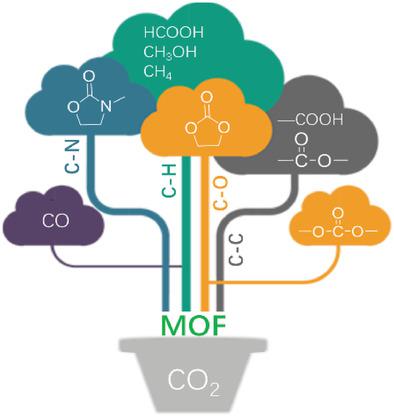当前位置:
X-MOL 学术
›
Adv. Mater.
›
论文详情
Our official English website, www.x-mol.net, welcomes your feedback! (Note: you will need to create a separate account there.)
Formation of CX Bonds in CO2 Chemical Fixation Catalyzed by Metal-Organic Frameworks.
Advanced Materials ( IF 29.4 ) Pub Date : 2019-06-19 , DOI: 10.1002/adma.201806163 Sheng-Li Hou 1 , Jie Dong 1 , Bin Zhao 1
Advanced Materials ( IF 29.4 ) Pub Date : 2019-06-19 , DOI: 10.1002/adma.201806163 Sheng-Li Hou 1 , Jie Dong 1 , Bin Zhao 1
Affiliation

|
Transformation of CO2 based on metal-organic framework (MOF) catalysts is becoming a hot research topic, not only because it will help to reduce greenhouse gas emission, but also because it will allow for the production of valuable chemicals. In addition, a large number of impressive products have been synthesized by utilizing CO2 . In fact, it is the formation of new covalent bonds between CO2 and substrate molecules that successfully result in CO2 solidly inserting into the products, and only four types of new CX bonds, including CH, CC, CN, and CO bonds, are observed in this exploration. An overview of recent progress in constructing CX bonds for CO2 conversion catalyzed by various MOF catalysts is provided. The catalytic mechanism of generating different CX bonds is further discussed according to both structural features of MOFs and the interactions among CO2 , substrates, as well as MOFs. The future opportunities and challenges in this field are also tentatively covered.
中文翻译:

金属有机骨架催化CO 2化学固定中CX键的形成。
基于金属有机框架(MOF)催化剂的CO2转化正成为一个热门研究课题,不仅因为它有助于减少温室气体排放,而且还因为它可以生产有价值的化学物质。另外,利用二氧化碳已经合成了许多令人印象深刻的产品。实际上,正是CO2与底物分子之间新的共价键的形成成功地导致了CO2牢固地插入产品中,并且只有四种新型的CX键,包括CH,CC,CN在此勘探中观察到,以及CO键。本文概述了在各种MOF催化剂的催化下建立CX键进行CO2转化的最新进展。根据MOF的结构特征以及CO 2,底物以及MOF之间的相互作用,进一步讨论了产生不同CX键的催化机理。该领域的未来机遇和挑战也被初步涵盖。
更新日期:2020-01-22
中文翻译:

金属有机骨架催化CO 2化学固定中CX键的形成。
基于金属有机框架(MOF)催化剂的CO2转化正成为一个热门研究课题,不仅因为它有助于减少温室气体排放,而且还因为它可以生产有价值的化学物质。另外,利用二氧化碳已经合成了许多令人印象深刻的产品。实际上,正是CO2与底物分子之间新的共价键的形成成功地导致了CO2牢固地插入产品中,并且只有四种新型的CX键,包括CH,CC,CN在此勘探中观察到,以及CO键。本文概述了在各种MOF催化剂的催化下建立CX键进行CO2转化的最新进展。根据MOF的结构特征以及CO 2,底物以及MOF之间的相互作用,进一步讨论了产生不同CX键的催化机理。该领域的未来机遇和挑战也被初步涵盖。


























 京公网安备 11010802027423号
京公网安备 11010802027423号